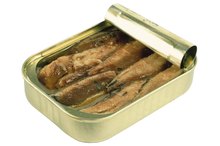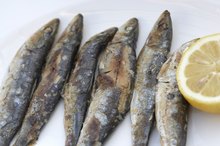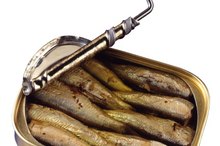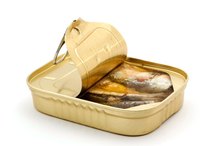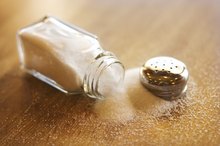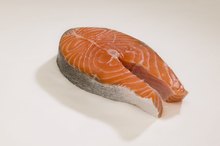What does fact checked mean?
At Healthfully, we strive to deliver objective content that is accurate and up-to-date. Our team periodically reviews articles in order to ensure content quality. The sources cited below consist of evidence from peer-reviewed journals, prominent medical organizations, academic associations, and government data.
The information contained on this site is for informational purposes only, and should not be used as a substitute for the advice of a professional health care provider. Please check with the appropriate physician regarding health questions and concerns. Although we strive to deliver accurate and up-to-date information, no guarantee to that effect is made.
Iodine Levels in Sardines
Iodine is an essential component of thyroid hormones that regulate metabolism, growth, reproduction and physiologic processes. Without it, each of these normal everyday functions may suffer. Almost all types of fish provide this important trace mineral. Consuming sardines significantly boosts your iodine intake, helping you meet your intake requirements for the day.
Sardines Explained
Sardines are fish that originate in oceans worldwide, in subtropical and tropical waters. They can live as long as 14 years of age, but about 90 percent of the population is under 6 years old. Sardines rarely grow longer than 9 inches in length, but the canned sardines you purchase from the grocery store are usually young and not longer than 2 or 3 inches. They are low in calories -- about 90 calories per 5 oz. serving -- full of minerals and provide heart-healthy monounsaturated and polyunsaturated fats, or MUFAs and PUFAs.
- Sardines are fish that originate in oceans worldwide, in subtropical and tropical waters.
- Sardines rarely grow longer than 9 inches in length, but the canned sardines you purchase from the grocery store are usually young and not longer than 2 or 3 inches.
Iodine Requirements
Can You Eat Sardines Before You Go to Sleep?
Learn More
As a healthy adult, you need 150 micrograms of iodine daily. Pregnancy ups your needs to 220 micrograms and lactating increases your requirement to 290 micrograms. While a large 5-ounce serving of sardines provides about 35 micrograms, read the nutrition facts label, since different varieties of sardines may vary slightly in iodine content.
- As a healthy adult, you need 150 micrograms of iodine daily.
- While a large 5-ounce serving of sardines provides about 35 micrograms, read the nutrition facts label, since different varieties of sardines may vary slightly in iodine content.
Iodine Deficiency
Iodine deficiency is rare in the United States, since many foods provide iodine in the form of iodized salt. Having a deficiency can cause your thyroid gland to swell, causing a lump at the base of your neck called "goiter." Additionally, iodine deficiency can lead to mental retardation, hypothyroidism, or lack of thyroid hormones, as well as an array of other developmental and growth abnormalities. Adding sardines to your diet once in awhile can be a pleasant alternative to other types of fish and help keep your iodine stores at optimal levels 2.
- Iodine deficiency is rare in the United States, since many foods provide iodine in the form of iodized salt.
- Having a deficiency can cause your thyroid gland to swell, causing a lump at the base of your neck called "goiter."
Ways to Eat Sardines
How to Eat Sardines for Thinning Hair
Learn More
You can eat canned sardines plain, right out of the can. If you can't get past the texture or flavor, mash them up in a food processor. Add the mixture to your fish dinner or sauce, for added flavor and an additional way to sneak in some iodine 2. Sardines are a close relative to anchovies and have a similar flavor. Switch up your Caesar salad by enjoying sardines instead of anchovies every so often. Sardines are also delicious when you lightly bread and saute them -- and serve with brown rice 2.
Related Articles
References
- Linus Pauling Institute: Iodine
- USDA National Nutrient Database for Standard Reference; Fish, Sardine, Atlantic, Canned in Oil, Drained Solids with Bone
- Fish, sardine, Atlantic, canned in oil, drained solids with bone. FoodData Central. U.S. Department of Agriculture. Published April 1, 2019.
- Innes JK, Calder PC. Marine omega-3 (N-3) fatty acids for cardiovascular health: An update for 2020. Int J Mol Sci. 2020;21(4):1362. doi:10.3390/ijms21041362
- University of Rochester Medical Center. Health encyclopedia: nutrition facts, fish, sardine, Atlantic, canned in oil, drained solids with bone, 1 sardines.
- Morris MC, Brockman J, Schneider JA, et al. Association of seafood consumption, brain mercury level, and APOE ε4 status with brain neuropathology in older adults. JAMA. 2016;315(5):489-497. doi:10.1001/jama.2015.19451
- Derbyshire E. Brain health across the lifespan: A systematic review on the role of omega-3 fatty acid supplements. Nutrients. 2018;10(8):1094. doi:10.3390/nu10081094
- Ellis E. 4 keys to strength building and muscle mass. Academy of Nutrition and Dietetics. Updated January 20, 2020.
- Chaddha A, Eagle KA. Omega-3 fatty acids and heart health. Circulation. 2015;132(22):e350-352. doi:10.1161/CIRCULATIONAHA.114.015176
- Balfegó M, Canivell S, Hanzu FA, et al. Effects of sardine-enriched diet on metabolic control, inflammation and gut microbiota in drug-naïve patients with type 2 diabetes: A pilot randomized trial. Lipids Health Dis. 2016;15:78. doi:10.1186/s12944-016-0245-0
- Moores S. Pregnant safe sources of omega-3 fats. Academy of Nutrition and Dietetics. Updated November 7, 2019.
- National Institutes of Health, Office of Dietary Supplements. Calcium fact sheet for professionals. Updated February 14, 2020.
- American College of Allergy Asthma & Immunology. Fish allergy. Updated March 21, 2019.
- Environmental Defense Fund. Sardines.
- U.S.Food & Drug Administration. Selecting and serving fresh and frozen seafood safely. Updated March 28, 2019.
Writer Bio
Melodie Anne Coffman specializes in overall wellness, with particular interests in women's health and personal defense. She holds a master's degree in food science and human nutrition and is a certified instructor through the NRA. Coffman is pursuing her personal trainer certification in 2015.
